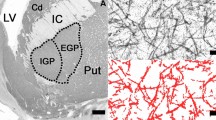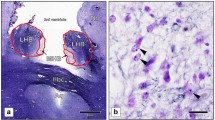Abstract
To investigate the topography of morphine distribution in the human brain, a method has been developed to detect morphine immunohistochemically. In this study hippocampus tissue from victims of heroin overdose (blood morphine concentrations 220 ng/g–1500 ng/g; 6-MAM positive urine sample), known for its high concentration of μ-opiate receptors was used. The immunohistochemical staining was performed with an anti-morphine antiserum originally developed for radio-immuno-assays. In comparison with control specimens from cases of sudden death without morphine exposition or a history of heroin abuse, the brains from victims of heroin overdose showed selectively stained ganglion cells, axons and dendrites, suggesting a massive concentration of morphine in the neuronal structures.
Similar content being viewed by others
Author information
Authors and Affiliations
Additional information
Received: 15 July 1998 / Received in revised form: 22 March 1999
Rights and permissions
About this article
Cite this article
Wehner, F., Wehner, HD., Subke, J. et al. Demonstration of morphine in ganglion cells of the hippocampus from victims of heroin overdose by means of anti-morphine antiserum. Int J Leg Med 113, 117–120 (2000). https://doi.org/10.1007/s004140050012
Issue Date:
DOI: https://doi.org/10.1007/s004140050012




